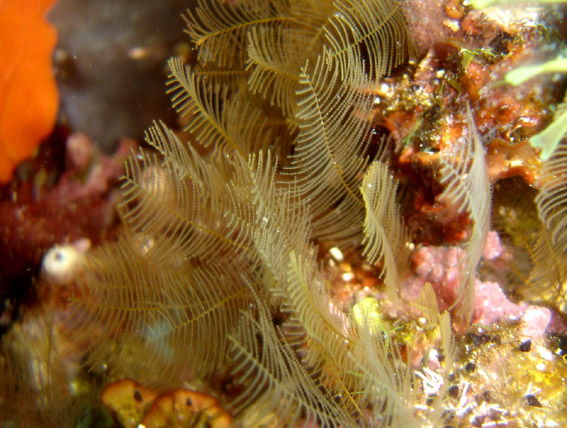- Plumularioidea
Taxobox
name = Plumularioidea

image_width = 240px
image_caption = "Aglaophenia " species (Aglaopheniidae )
regnum =Animal ia
subregnum =Eumetazoa
phylum =Cnidaria
subphylum =Medusozoa
classis =Hydrozoa
subclassis =Leptolinae
ordo =Leptomedusae
subordo = Conica
superfamilia = Plumularioidea
subordo_authority =
subdivision_ranks = Families
subdivision = 4, see textPlumularioidea are one of the few rather robustly established
superfamilies of thecnidaria nsuborder Conica.This superfamily unites about 30
genera in the following families:Schuchert (2008)]
*Aglaopheniidae Marktanner-Turneretscher, 1890
*Halopterididae
*Kirchenpaueriidae
*Plumulariidae Agassiz, 1862These thecate hydroids grow in erect colonies, branched in some
species but unbranched in others. Each branch may bear a single or several animals. In the latter case thehydrotheca e are arranged in a neat single file; in either case they are not set on stalks but grow from the branches directly. The hydrothecase have a cusped or even rim and instead of adiaphragm a well-defined floor with ahydropore that is usually off-center. Thehydranth s have a conicalhypostome - as is typical for the suborder Conica - and a single whorl of thread-liketentacle s. Thegastrodermis contains areas with and others without digestive function.Nematophore s are always present and usually protected bynematotheca e. Thegonotheca are borne singly or in groups, they may or may not have protective hydrocladia or appendages. Thegonophore s are usually fixedsporosac s, more rarely they are rather reducedmedusoid s.Footnotes
References
* (2008): [http://www.ville-ge.ch/mhng/hydrozoa/hydrozoa-directory.htm The Hydrozoa Directory] - [http://www.ville-ge.ch/mhng/hydrozoa/lepto/conica.htm Suborder Conica Broch, 1910] . Retrieved 2008-JUL-08.
Wikimedia Foundation. 2010.
